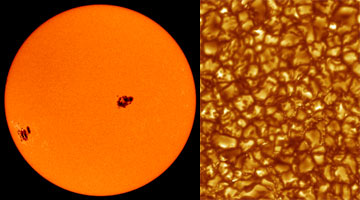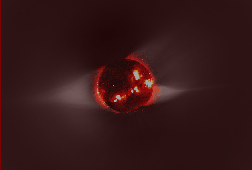The TRACE spacecraft mated to the Pegasus XL rocket on which it will be launched.
Click on image for full size
Courtesy of NASA
TRACING the Sun...
News story originally written on March 24, 1998
On March 30, 1998, the TRACE spacecraft will be launched. TRACE stands for Transition Region and Coronal Explorer (try saying that fast three times!). This spacecraft has four telescopes on it. The telescopes will focus in on the transition region of the Sun, that region between the
cool surface (only 6,000 degrees Fahrenheit!) and the
corona where temperatures are as much as 16 million degrees Fahrenheit.
The TRACE is being launched just in time for the solar cycle to reach its peak. TRACE joins a fleet of spacecraft studying the Sun during this active time (like the ACE and Ulysses spacecraft).
TRACE, which costs $49 million, is the third spacecraft in the Small Explorer series of small, relatively low-cost missions.
You might also be interested in:

Most of the energy we receive from the Sun is the visible (white) light emitted from the photosphere. The photosphere is one of the coolest regions of the Sun (6000 K), so only a small fraction (0.1%)
...more
Rising above the Sun's chromosphere , the temperature jumps sharply from a few tens of thousands of kelvins to as much as a few million kelvins in the Sun's outer atmosphere, the solar corona. Understanding
...more
It was another exciting and frustrating year for the space science program. It seemed that every step forward led to one backwards. Either way, NASA led the way to a great century of discovery. Unfortunately,
...more
The Space Shuttle Discovery lifted off from Kennedy Space Center on October 29th at 2:19 p.m. EST. The weather was great as Discovery took 8 1/2 minutes to reach orbit. This was the United States' 123rd
...more
A moon was discovered orbiting the asteroid, Eugenia. This is only the second time in history that a satellite has been seen circling an asteroid. A special mirror allowed scientists to find the moon
...more
Will Russia ever put the service module for the International Space Station in space? NASA officials want an answer from the Russian government. The necessary service module is currently waiting to be
...more
A coronal mass ejection (CME) happened on the Sun early last month. The material that was thrown out from this explosion passed the ACE spacecraft. The SWICS instrument on ACE has produced a new and very
...more















